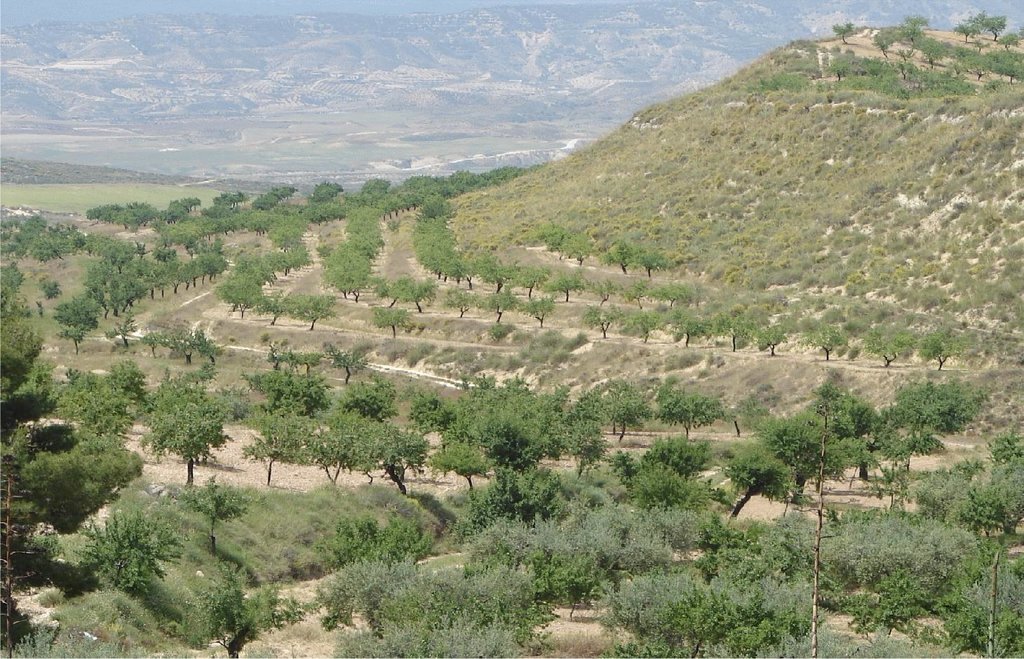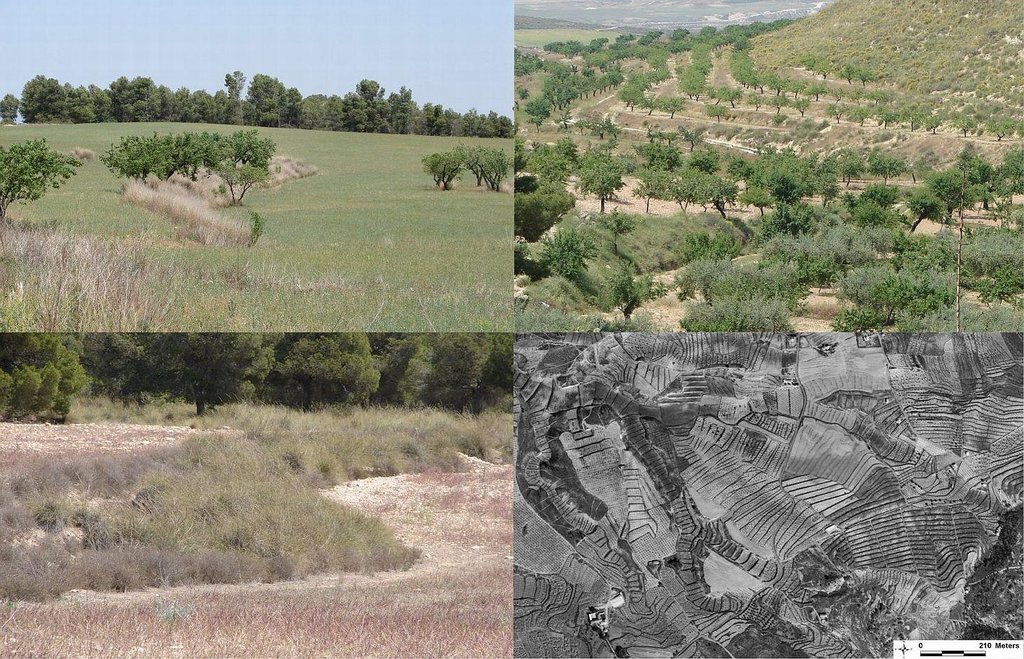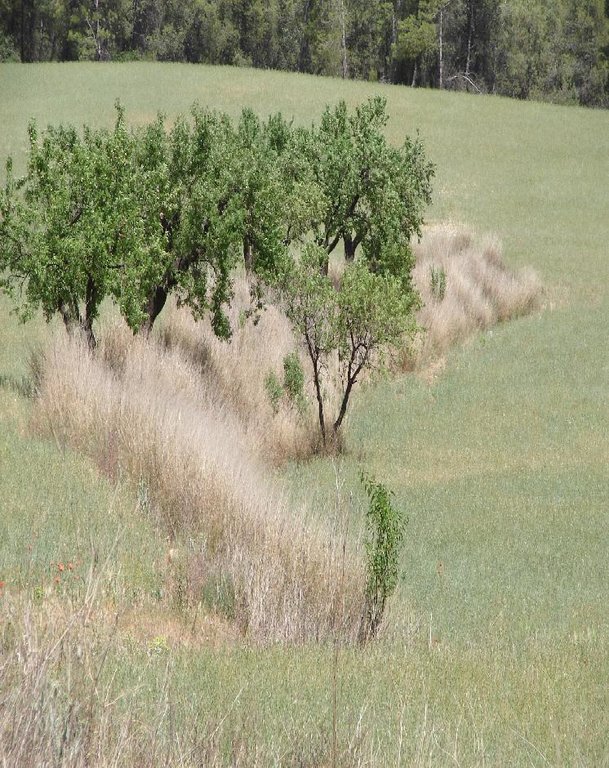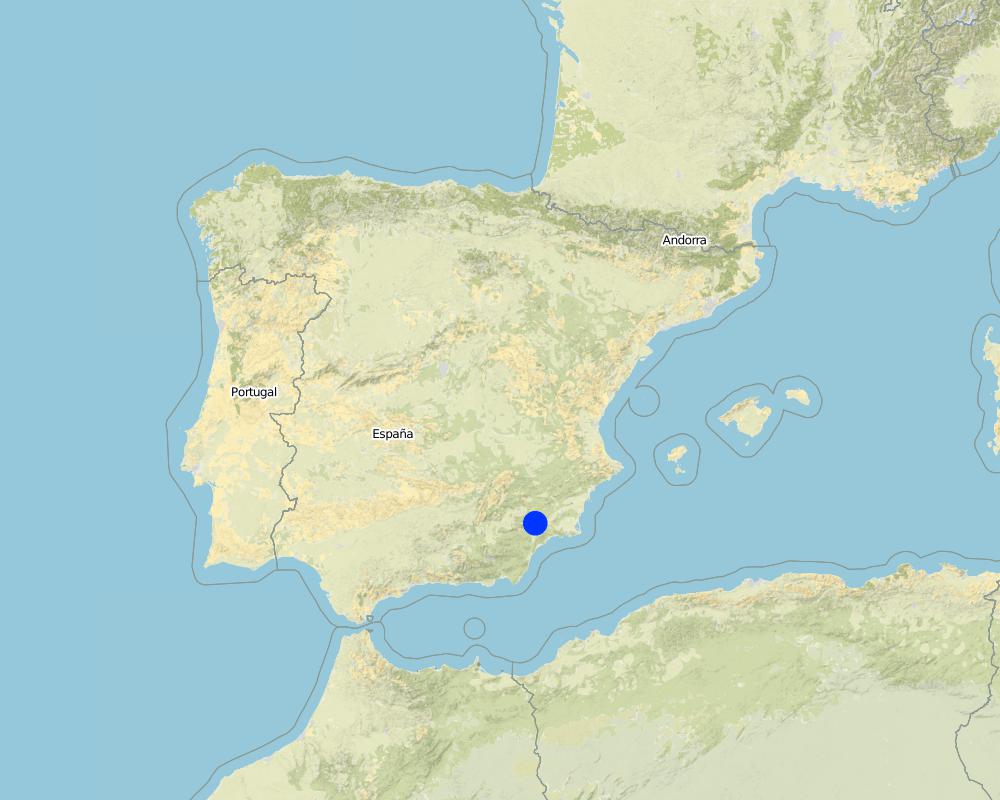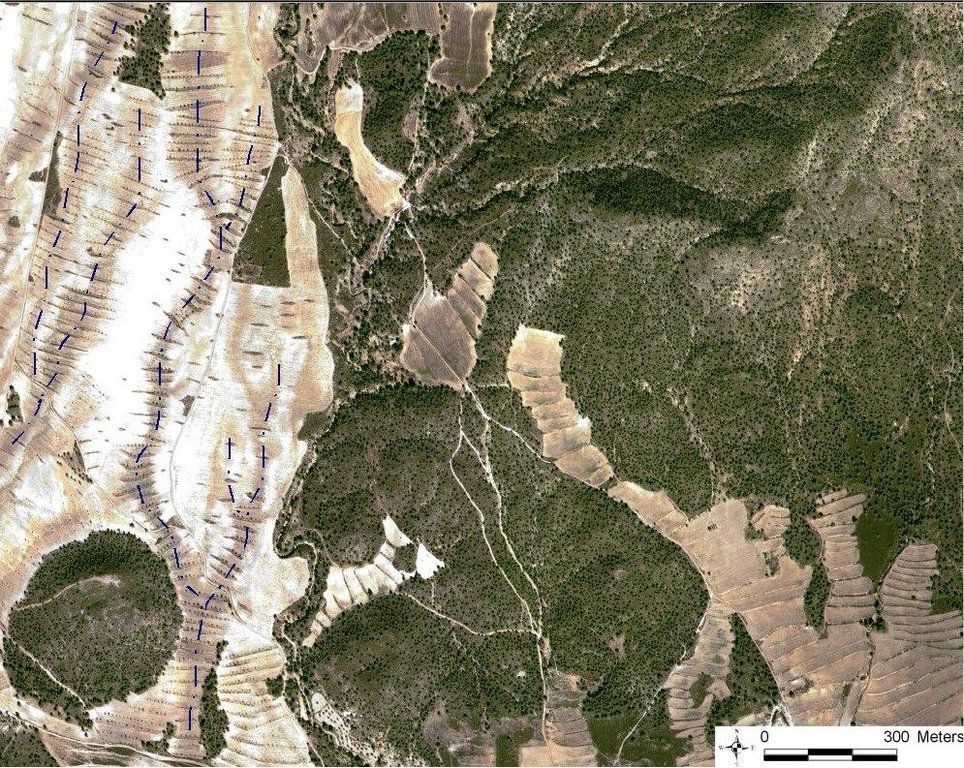Vegetated earth-banked terraces [Spain]
- Creation:
- Update:
- Compiler: Joris De Vente
- Editor: –
- Reviewers: Deborah Niggli, Alexandra Gavilano
Terrazas de tierra vegetadas (Spanish)
technologies_1516 - Spain
View sections
Expand all Collapse all1. General information
1.2 Contact details of resource persons and institutions involved in the assessment and documentation of the Technology
SLM specialist:
SLM specialist:
López Carratala Jorge
Consejo Superior de Investigaciones Científicas, Estación Experimental de Zonas Áridas (EEZA-CSIC)
Spain
Name of project which facilitated the documentation/ evaluation of the Technology (if relevant)
DESIRE (EU-DES!RE)Name of the institution(s) which facilitated the documentation/ evaluation of the Technology (if relevant)
EEZA-CSIC (EEZA-CSIC) - Spain1.3 Conditions regarding the use of data documented through WOCAT
The compiler and key resource person(s) accept the conditions regarding the use of data documented through WOCAT:
Yes
1.5 Reference to Questionnaire(s) on SLM Approaches (documented using WOCAT)
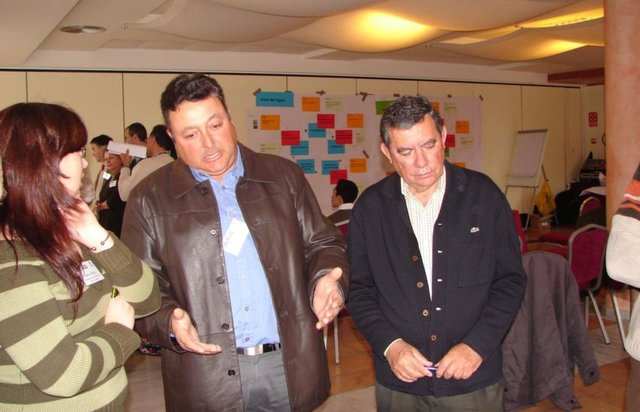
Regional rural development programme [Spain]
Regional development programme to protect natural resources and stimulate rural economies.
- Compiler: Joris De Vente
2. Description of the SLM Technology
2.1 Short description of the Technology
Definition of the Technology:
Earth-banked terraces in cereal and almond cropland covered with drought-resistant shrubs.
2.2 Detailed description of the Technology
Description:
Earth-banked terraces are constructed by carefully removing a superficial soil layer (~10-20 cm) from one part of a field, concentrating it on the lower end of that field in order to reduce slope gradient and length. Another terrace is created directly downslope to form a cascade of terraces. Terrace risers have to be of restricted height (~50-150 cm) to prevent steep and unstable terraces. Stones from the fields can be used to reinforce the terrace ridge. After terrace construction, fields should be gently sloping (<3%) in the direction of the main slope. The distance between terraces must be enough to allow tractor movement during normal cultivation activities and it depends also on the slope gradient. The steeper the slope, the shorter is the distance between terraces. Terraces reduce the formation of gullies and retain water from upslope. The terraces are made with locally available machinery (tractor, small bulldozer). The terrace ridges are optimal locations to plant olives, almonds or fruit trees. Moreover, to be most effective, the terrace ridges are vegetated with shrubs adapted to semi-arid conditions and with a good surface cover (>~30%) throughout the year (e.g. Stipa tenacisima, Rosmarinus officinalis, Thymus vulgaris, Ulex parviflorus, Rhamnus lycioides, Pistacia lentiscus). Natural regeneration of vegetation is allowed without limitation on the terrace ridges, so no herbicide application or burning are carried out to remove weeds. Where possible, regeneration should be stimulated by planting the same adapted species in at least 25% of the terrace ridge. Optionally, in the other 75% of the terrace ridge, cereals or other leguminous species can be sown, but should not be harvested or used for grazing.
Purpose of the Technology: This technology reduces flooding, damage to infrastructure and siltation of water reservoirs, while maintaining (or slightly increasing) crop productivity. This is achieved by reducing runoff, soil erosion and hydraulic connectivity through a decreased slope gradient and an increased vegetation cover. The terrace ridge functions as a sink for runoff within fields and reduces runoff velocity. The vegetation leads to increased soil organic matter content below plants, producing an improved soil structure and a higher infiltration capacity. The use of stones from the fields to reinforce the terraces is optional, but facilitates crop production in the fields and makes the ridges more resistant to higher runoff velocities. The technology requires an initial investment in the construction of the terraces. Terraces can best be located on thalwegs and on areas where gully formation is often observed. Maintenance consists of filling up possible bank gullies developed in the terraces after important rainfall events and, if needed, substitute decayed shrubs with new ones.
Natural / human environment: The technology is generally applied on soils of shallow to medium depth (20 – 60 cm), and slopes are gentle to moderate (5-15%). The climate is semi-arid with a mean annual rainfall around 300 mm. Droughts, peaking in summer commonly last for more than 4-5 months. Annual potential evapotranspiration rates larger than 1000 mm are common. The production system is highly mechanized and market-oriented but depends strongly on agricultural subsidies. All cropland is privately-owned.
2.3 Photos of the Technology
2.5 Country/ region/ locations where the Technology has been applied and which are covered by this assessment
Country:
Spain
Region/ State/ Province:
Murcia
Further specification of location:
Guadalentin catchment
Specify the spread of the Technology:
- evenly spread over an area
If precise area is not known, indicate approximate area covered:
- 10-100 km2
Map
×2.6 Date of implementation
If precise year is not known, indicate approximate date:
- more than 50 years ago (traditional)
2.7 Introduction of the Technology
Specify how the Technology was introduced:
- as part of a traditional system (> 50 years)
Comments (type of project, etc.):
Most of the earthen terraces are already much older than 50 years. Recently, the regional administration is promoting clearly defined vegetated strips with minimum dimensions in order to apply for subsidies.
3. Classification of the SLM Technology
3.2 Current land use type(s) where the Technology is applied
Land use mixed within the same land unit:
Yes
Specify mixed land use (crops/ grazing/ trees):
- Agroforestry

Cropland
- Annual cropping
- Tree and shrub cropping
Tree and shrub cropping - Specify crops:
- tree nuts (brazil nuts, pistachio, walnuts, almonds, etc.)
Number of growing seasons per year:
- 1
Specify:
Longest growing period in days: 220Longest growing period from month to month: November to June

Grazing land

Forest/ woodlands
- (Semi-)natural forests/ woodlands
Comments:
Major land use problems (compiler’s opinion): A lack of water availability seriously limits the production potential of the soil and results in a low vegetation/crop cover. The relatively high soil erosion rates cause various off-site related problems (i.e. flooding, reservoir siltation) and on-site problems (i.e. gully formation and loss of soil depth).
Major land use problems (land users’ perception): Lack of water for irrigation of crops limiting the crop types that can be planted as well as the crop yield of dryland farming.
Number of growing seasons per year:
1
Specify:
Longest growing period in days: 220Longest growing period from month to month: November to June
3.5 SLM group to which the Technology belongs
- improved ground/ vegetation cover
- cross-slope measure
3.6 SLM measures comprising the Technology

vegetative measures
- V1: Tree and shrub cover
- V2: Grasses and perennial herbaceous plants

structural measures
- S1: Terraces
Comments:
Main measures: vegetative measures, structural measures
Type of vegetative measures: aligned: -contour
3.7 Main types of land degradation addressed by the Technology

soil erosion by water
- Wt: loss of topsoil/ surface erosion
- Wg: gully erosion/ gullying
- Wo: offsite degradation effects

water degradation
- Ha: aridification
Comments:
Main type of degradation addressed: Wt: loss of topsoil / surface erosion, Wg: gully erosion / gullying, Wo: offsite degradation effects
Secondary types of degradation addressed: Ha: aridification
Main causes of degradation: crop management (annual, perennial, tree/shrub) (Almond and cereal fields often have a relatively low surface cover by vegetation during long periods of the year, leaving the soil unprotected against raindrop impact and rill or gully formation), disturbance of water cycle (infiltration / runoff) (Reduced infiltration capacity causing runoff and soil erosion), other human induced causes (specify) (Cropping of relatively steep slopes sensitive to erosion because of slope gradient), governance / institutional (spatial planning of land use results in formation of too large fields without field boundaries)
Secondary causes of degradation: Heavy / extreme rainfall (intensity/amounts) (High intensity erosive rainfall is common), droughts (Dry periods and dry years require higher water availability)
3.8 Prevention, reduction, or restoration of land degradation
Specify the goal of the Technology with regard to land degradation:
- prevent land degradation
- reduce land degradation
Comments:
Main goals: prevention of land degradation, mitigation / reduction of land degradation
4. Technical specifications, implementation activities, inputs, and costs
4.1 Technical drawing of the Technology
Technical specifications (related to technical drawing):
Quickbird satellite image showing the concentration of terraces along natural drainage lines (thalwegs) where runoff concentrates. Drainage lines are indicated with dotted lines.
Location: Torrealvillla. Murcia
Date: Satellite image 2003
Technical knowledge required for field staff / advisors: moderate (Design of the terraces and selection of the location requires some technical knowledge.)
Technical knowledge required for land users: low (Practical implementation of the terraces does not require a high level of knowledge)
Main technical functions: control of dispersed runoff: retain / trap, control of dispersed runoff: impede / retard, control of concentrated runoff: retain / trap, control of concentrated runoff: impede / retard, reduction of slope angle, increase of infiltration, increase / maintain water stored in soil
Secondary technical functions: reduction of slope length, improvement of ground cover, stabilisation of soil (eg by tree roots against land slides), increase in organic matter, water harvesting / increase water supply, sediment retention / trapping, sediment harvesting, spatial arrangement and diversification of land use
Aligned: -contour
Vegetative material: F : fruit trees / shrubs
Number of plants per (ha): 42
Vertical interval between rows / strips / blocks (m): 1
Spacing between rows / strips / blocks (m): 30-100
Vertical interval within rows / strips / blocks (m): 0.5-7
Width within rows / strips / blocks (m): 2
Vegetative measure: alligned: contour
Vegetative material: G : grass
Number of plants per (ha): >30% cover
Vertical interval between rows / strips / blocks (m): 1
Spacing between rows / strips / blocks (m): 30-100
Vertical interval within rows / strips / blocks (m): 0.5
Width within rows / strips / blocks (m): 2
Vegetative measure: Vegetative material: G : grass
Vegetative measure: Vegetative material: G : grass
Vegetative measure: Vegetative material: G : grass
Fruit trees / shrubs species: natural regeneration of shrubs with possible additional plantation of almond trees and/or woody shru
Grass species: Natural regeneration assisted by seeding of legiminous species and cereals
Slope (which determines the spacing indicated above): 10.00%
Terrace: forward sloping
Vertical interval between structures (m): 1
Spacing between structures (m): 30-100
Height of bunds/banks/others (m): 0.5-1.5
Width of bunds/banks/others (m): 2
Length of bunds/banks/others (m): 50-200
Construction material (stone): Only when many stones are present in the fields
Slope (which determines the spacing indicated above): 5-15%
If the original slope has changed as a result of the Technology, the slope today is: <3%
Lateral gradient along the structure: 0%
Vegetation is used for stabilisation of structures.
Author:
Joris de Vente
4.2 General information regarding the calculation of inputs and costs
other/ national currency (specify):
EURO
If relevant, indicate exchange rate from USD to local currency (e.g. 1 USD = 79.9 Brazilian Real): 1 USD =:
0.63
Indicate average wage cost of hired labour per day:
79.00
4.3 Establishment activities
| Activity | Timing (season) | |
|---|---|---|
| 1. | Plantation of shrubs and cereals or Leguminous species (optional) | Autumn - winter |
| 2. | Construction of terraces | autumn or winter |
4.4 Costs and inputs needed for establishment
| Specify input | Unit | Quantity | Costs per Unit | Total costs per input | % of costs borne by land users | |
|---|---|---|---|---|---|---|
| Labour | Labour | ha | 1.0 | 270.0 | 270.0 | 10.0 |
| Equipment | Machine use | ha | 1.0 | 428.0 | 428.0 | 12.0 |
| Plant material | shrub seedlings and seeds | ha | 1.0 | 218.0 | 218.0 | 10.0 |
| Total costs for establishment of the Technology | 916.0 | |||||
| Total costs for establishment of the Technology in USD | 1453.97 | |||||
Comments:
Duration of establishment phase: 12 month(s)
4.5 Maintenance/ recurrent activities
| Activity | Timing/ frequency | |
|---|---|---|
| 1. | Replace died shrubs (optional) | autumn-winter |
| 2. | Filling up bank gullies in terraces | twice a year or after heavy rainstorms |
4.6 Costs and inputs needed for maintenance/ recurrent activities (per year)
| Specify input | Unit | Quantity | Costs per Unit | Total costs per input | % of costs borne by land users | |
|---|---|---|---|---|---|---|
| Labour | Labour | ha | 1.0 | 28.0 | 28.0 | 10.0 |
| Equipment | Machine use | ha | 1.0 | 24.0 | 24.0 | 10.0 |
| Plant material | Shrub seedlings and seeds | ha | 1.0 | 22.0 | 22.0 | 10.0 |
| Total costs for maintenance of the Technology | 74.0 | |||||
| Total costs for maintenance of the Technology in USD | 117.46 | |||||
Comments:
Machinery/ tools: For initial construction a large tractor or small bulldozer is required. For maintanance a normal tractor can be used.
The costs were indicated assuming a distance between terraces of 50 meter, meaning two terraces of 100 meter long per hectare. Prices are for spring 2008. Subsidies are foreseen for the installation of the vegetated terraces and for maintenance during at least 4 years if all requirements are fullfilled that are described in the regional development programme.
4.7 Most important factors affecting the costs
Describe the most determinate factors affecting the costs:
Price of fuel and labour are the most important determinants of the costs.
5. Natural and human environment
5.1 Climate
Annual rainfall
- < 250 mm
- 251-500 mm
- 501-750 mm
- 751-1,000 mm
- 1,001-1,500 mm
- 1,501-2,000 mm
- 2,001-3,000 mm
- 3,001-4,000 mm
- > 4,000 mm
Specify average annual rainfall (if known), in mm:
300.00
Specifications/ comments on rainfall:
Dry period in summer during 3-4 months (June – August/September)
Agro-climatic zone
- semi-arid
Thermal climate class: subtropics
Thermal climate class: temperate. The higher parts are generally somewhat colder
5.2 Topography
Slopes on average:
- flat (0-2%)
- gentle (3-5%)
- moderate (6-10%)
- rolling (11-15%)
- hilly (16-30%)
- steep (31-60%)
- very steep (>60%)
Landforms:
- plateau/plains
- ridges
- mountain slopes
- hill slopes
- footslopes
- valley floors
Altitudinal zone:
- 0-100 m a.s.l.
- 101-500 m a.s.l.
- 501-1,000 m a.s.l.
- 1,001-1,500 m a.s.l.
- 1,501-2,000 m a.s.l.
- 2,001-2,500 m a.s.l.
- 2,501-3,000 m a.s.l.
- 3,001-4,000 m a.s.l.
- > 4,000 m a.s.l.
Indicate if the Technology is specifically applied in:
- concave situations
Comments and further specifications on topography:
Landforms: Hill slopes-footslopes (mostly on concave slope segments)
5.3 Soils
Soil depth on average:
- very shallow (0-20 cm)
- shallow (21-50 cm)
- moderately deep (51-80 cm)
- deep (81-120 cm)
- very deep (> 120 cm)
Soil texture (topsoil):
- medium (loamy, silty)
- fine/ heavy (clay)
Topsoil organic matter:
- medium (1-3%)
- low (<1%)
5.4 Water availability and quality
Ground water table:
5-50 m
Availability of surface water:
poor/ none
Water quality (untreated):
for agricultural use only (irrigation)
Comments and further specifications on water quality and quantity:
Ground water table: >50m (There is a lowering of groundwater table due to overexploitation for irrigation purposes)
Availability of surface water: Poor/none (excess: sporadically there are flash floods during extreme rainfall events)
Water quality (untreated): For agricultural use only (irrigation) (groundwater)
5.5 Biodiversity
Species diversity:
- low
5.6 Characteristics of land users applying the Technology
Off-farm income:
- > 50% of all income
Relative level of wealth:
- average
Individuals or groups:
- individual/ household
Gender:
- men
Indicate other relevant characteristics of the land users:
Land users applying the Technology are mainly common / average land users
Difference in the involvement of women and men: Traditionally most agriculture is done by men in this region.
Population density: 10-50 persons/km2
Annual population growth: < 0.5%
15% of the land users are rich and own 20% of the land.
80% of the land users are average wealthy and own 75% of the land.
5% of the land users are poor and own 5% of the land.
Off-farm income specification: There is no difference in the ones who apply the technology and those who don’t. Most farmers do have an off-farm income for example from hunting, work in a factory, or office.
5.7 Average area of land used by land users applying the Technology
- < 0.5 ha
- 0.5-1 ha
- 1-2 ha
- 2-5 ha
- 5-15 ha
- 15-50 ha
- 50-100 ha
- 100-500 ha
- 500-1,000 ha
- 1,000-10,000 ha
- > 10,000 ha
Is this considered small-, medium- or large-scale (referring to local context)?
- medium-scale
5.8 Land ownership, land use rights, and water use rights
Land ownership:
- individual, titled
Land use rights:
- individual
Water use rights:
- individual
Comments:
All cropland is privately owned. Some shrubland or forest is state property. Water use is organised by permits to water extraction from aquifers on individual basis. Water rights are provided and controlled by the Water authority of the Segura river basin (CHS).
5.9 Access to services and infrastructure
health:
- poor
- moderate
- good
education:
- poor
- moderate
- good
technical assistance:
- poor
- moderate
- good
employment (e.g. off-farm):
- poor
- moderate
- good
markets:
- poor
- moderate
- good
energy:
- poor
- moderate
- good
roads and transport:
- poor
- moderate
- good
drinking water and sanitation:
- poor
- moderate
- good
financial services:
- poor
- moderate
- good
6. Impacts and concluding statements
6.1 On-site impacts the Technology has shown
Socio-economic impacts
Production
crop production
Comments/ specify:
Depending on local conditions yield may be the same or increase slightly
land management
Comments/ specify:
Field paths become shorter, so more tractor movement is required (not more kilometres!)
Income and costs
expenses on agricultural inputs
Comments/ specify:
Implementation of terraces is considered relatively expensive
farm income
Comments/ specify:
Depends on crop yield.
workload
Comments/ specify:
Less damage to fields due to less gully formation
Socio-cultural impacts
SLM/ land degradation knowledge
conflict mitigation
Comments/ specify:
Less damage to neighbours fields by gullies and flooding
Improved livelihoods and human well-being
Comments/ specify:
There is less damage to fields and to infrastructure due to gully formation and flooding.
Ecological impacts
Water cycle/ runoff
harvesting/ collection of water
Comments/ specify:
On the long term higher infiltration capacity of the soil
surface runoff
groundwater table/ aquifer
Soil
soil moisture
soil cover
Comments/ specify:
Vegetation on the terraces increases vegetation cover
soil loss
soil organic matter/ below ground C
Comments/ specify:
Provided by the vegetation on the terraces
Biodiversity: vegetation, animals
biomass/ above ground C
Comments/ specify:
Provided by the vegetation on the terraces
plant diversity
animal diversity
Comments/ specify:
Terraces provide corridors connecting fields and provide shelter
beneficial species
habitat diversity
6.2 Off-site impacts the Technology has shown
downstream flooding
downstream siltation
buffering/ filtering capacity
damage on neighbours' fields
damage on public/ private infrastructure
6.3 Exposure and sensitivity of the Technology to gradual climate change and climate-related extremes/ disasters (as perceived by land users)
Gradual climate change
Gradual climate change
| Season | increase or decrease | How does the Technology cope with it? | |
|---|---|---|---|
| annual temperature | increase | not well |
Comments:
The crop type is sensitive to changes in water availability under the semi arid conditions
6.4 Cost-benefit analysis
How do the benefits compare with the establishment costs (from land users’ perspective)?
Short-term returns:
negative
Long-term returns:
neutral/ balanced
How do the benefits compare with the maintenance/ recurrent costs (from land users' perspective)?
Short-term returns:
neutral/ balanced
Long-term returns:
slightly positive
Comments:
Implementation of the terraces is relatively expensive. Additionally planting of shrubs is also relatively expensive and requires a subsidy. Once installed, maintenance is not expensive and pays off because of less damage to fields and infrastructure.
6.5 Adoption of the Technology
Of all those who have adopted the Technology, how many did so spontaneously, i.e. without receiving any material incentives/ payments?
- 11-50%
Comments:
80% of land user families have adopted the Technology with external material support
Comments on acceptance with external material support: Terraces are traditionally widespread in the region. Most of them were installed without external support. Nowadays there are subsidies for construction and maintenance of vegetated strips and terraces.
20% of land user families have adopted the Technology without any external material support
There is no trend towards spontaneous adoption of the Technology
Comments on adoption trend: There is acceptance, but it is not growing. In some parts terraces are removed to make larger fields, and some new ones are also constructed. Recently installed subsidies may change this
6.7 Strengths/ advantages/ opportunities of the Technology
| Strengths/ advantages/ opportunities in the land user’s view |
|---|
|
The terraces prevent gully formation and damage to the fields and to their neighbours How can they be sustained / enhanced? maintenance is needed and should be promoted. |
| Strengths/ advantages/ opportunities in the compiler’s or other key resource person’s view |
|---|
|
This technology is very effective at reducing surface runoff and erosion by reducing slope gradients and connectivity. In addition, it has a water harvesting effect. So it reduces on-site and off-site erosion problems and potentially increases water retention in the fields. How can they be sustained / enhanced? The technology can be enhanced by providing more info and publicity so that existing terraces are maintained. |
6.8 Weaknesses/ disadvantages/ risks of the Technology and ways of overcoming them
| Weaknesses/ disadvantages/ risks in the land user’s view | How can they be overcome? |
|---|---|
| It is considered relatively expensive to implement and particularly the optional planting of woody species is considered complicated in dry years | Subsidies for terrace construction and planting of woody species as well as cooperation between farmers to reduce costs of maintenance when subsidies stop. |
| Weaknesses/ disadvantages/ risks in the compiler’s or other key resource person’s view | How can they be overcome? |
|---|---|
| The technology does not significantly improve farm income and has a significant implementation cost. | Provide information on all the advantages that include many costs for society (including floods, reservoir siltation etc.). The subsidy for implementation already solves the problem of implementation costs. |
7. References and links
7.1 Methods/ sources of information
7.2 References to available publications
Title, author, year, ISBN:
Garcia-Fayos, P. and Gasque, M., 2002. Consequences of a severe drought on spatial patterns of woody plants in a two-phase mosaic steppe of Stipa tenacissima L. Journal of Arid Environments, 52(2): 199-208.
Available from where? Costs?
internet
Title, author, year, ISBN:
Hooke, J.M., 2006. Human impacts on fluvial systems in the Mediterranean region. Geomorphology, 79(3-4): 311-335.
Available from where? Costs?
internet
Title, author, year, ISBN:
Kirkby, M.J., Bracken, L.J. and Shannon, J., 2005. The influence of rainfall distribution and morphological factors on runoff delivery from dryland catchments in SE Spain. CATENA, 62(2-3): 136-156.
Available from where? Costs?
internet
7.3 Links to relevant online information
Title/ description:
CARM 2008. Programa de Desarrollo Rural de la Región de Murcia 2007-2013 Tomo I. 508pp
URL:
http://www.carm.es/neweb2/servlet/integra.servlets.ControlPublico?IDCONTENIDO=4689&IDTIPO=100&RASTRO=c431$m1219
Links and modules
Expand all Collapse allLinks

Regional rural development programme [Spain]
Regional development programme to protect natural resources and stimulate rural economies.
- Compiler: Joris De Vente
Modules
No modules



